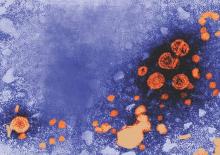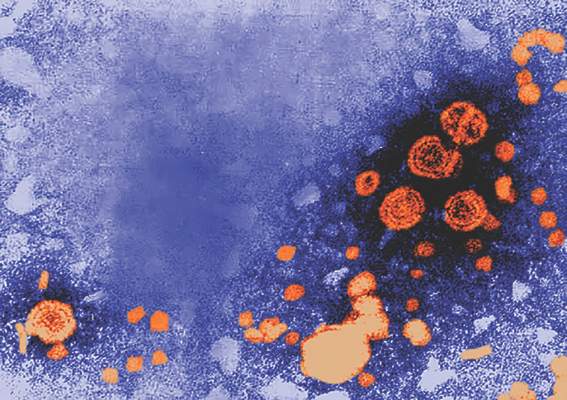User login
SAN FRANCISCO – ARC-520, the first RNA interference–based drug to reach patients, produced deep and durable knockdown of viral antigens and DNA in chronic hepatitis B patients in a phase II study.
Of 58 patients with chronic hepatitis B (CHB) who were included in the study, 38 were hepatitis B e antigen negative (HBeAg-neg), and 20 were hepatitis B e antigen positive (HBeAg-pos). At enrollment, 32 of the 38 HBeAG-neg, and 14 of the 20 HBeAG-pos patients were treated with entecavir (mean duration, 5 years) and remained on that treatment throughout the study, and the remaining 6 patients in each group initiated entecavir treatment during the study, Dr. Man-Fung Yuen of the University of Hong Kong, China reported at the annual meeting of the American Association for the Study of Liver Diseases.
All subjects received either an intravenous dose of ARC (Arrowhead Research Corporation)-520 (48 patients) or placebo (10 patients). The dose was 1-4 mg/kg, divided and given 2 weeks apart in the HBeAg-neg patients, and was 4 mg/kg in the HBeAg-pos patients.
Knockdown of viral parameters was measured over 85 days.
Viral DNA measures showed levels below the threshold for quantification in all patients on entecavir at study entry. Those who were entecavir naive at entry had reduced viral DNA up to 4.3 log (mean, 2.2 log) after treatment with ARC and entecavir, he noted.
ARC reduced viral antigens with quantitative HBeAg (qHBeAg) with best knockdown of 1.7 log after a single 4 mg/kg dose. In treatment-naive patients, the best observed quantitative hepatitis B surface antigen (qHBsAg) knockdown was 1.9 log (99%) in HBeAg-pos patients, and 0.7 log in HBeAg-neg patients (mean max, 1.2 log and 1.1 log, respectively).
A dose-response was seen for quantitative hepatitis B core-related antigen (qHBcrAg) in HBeAg-neg patients, with best knockdown of 0.18 log at a dose of 1 mg/kg (mean max, 0.15 log), and best knockdown of 1.1 log at 4 mg/kg (mean max, 0.9 log). HbeAg-pos showed best knockdown of 1.1 log (mean max, 0.92 log).
The qHBsAg dose response was less deep in patients treated chronically with entecavir (best observed reduction of 0.3 log at 1 mg/kg (mean max, 0.2 log) vs. 0.5 log at 4 mg/kg (mean max, 0.4 log) in HBeAg-neg, and 0.7 log in HBeAg-pos patients (mean max, 0.3).
Divided doses at 4 mg/kg did not increase antigen knockdown, Dr. Yuen noted.
The duration of qHBsAG knockdown was typically 8 weeks, and two distinct knockdown patterns were noted, including an immediate, direct ARC antiviral effect in about 70% of patients, and a delayed response of several weeks after treatment in about 30% of patients, he said.
Chronic hepatitis B has become an important target for drug development, and ARC-520, which targets covalently close circular DNA (ccc-DNA)-derived messenger RNA, is of particular interest. The findings of the current study, which suggest more ccc-DNA–driven antigen production in HBeAg-pos disease, are consistent with those from studies in chimpanzees, as well as with previously reported chronic entecavir reductions in patients for ccc-DNA, Dr. Yuen said.
Studies are currently underway to evaluate the ability of chronic ARC therapy to produce HBsAG seroclearance, he noted.
Dr. Yuen reported advisory committee or review panel participation with GlaxoSmithKline, Bristol-Myers Squibb, and Pfizer, and grant or research support from Roche, Bristol-Myers Squibb, Pfizer, and Gilead Science.
SAN FRANCISCO – ARC-520, the first RNA interference–based drug to reach patients, produced deep and durable knockdown of viral antigens and DNA in chronic hepatitis B patients in a phase II study.
Of 58 patients with chronic hepatitis B (CHB) who were included in the study, 38 were hepatitis B e antigen negative (HBeAg-neg), and 20 were hepatitis B e antigen positive (HBeAg-pos). At enrollment, 32 of the 38 HBeAG-neg, and 14 of the 20 HBeAG-pos patients were treated with entecavir (mean duration, 5 years) and remained on that treatment throughout the study, and the remaining 6 patients in each group initiated entecavir treatment during the study, Dr. Man-Fung Yuen of the University of Hong Kong, China reported at the annual meeting of the American Association for the Study of Liver Diseases.
All subjects received either an intravenous dose of ARC (Arrowhead Research Corporation)-520 (48 patients) or placebo (10 patients). The dose was 1-4 mg/kg, divided and given 2 weeks apart in the HBeAg-neg patients, and was 4 mg/kg in the HBeAg-pos patients.
Knockdown of viral parameters was measured over 85 days.
Viral DNA measures showed levels below the threshold for quantification in all patients on entecavir at study entry. Those who were entecavir naive at entry had reduced viral DNA up to 4.3 log (mean, 2.2 log) after treatment with ARC and entecavir, he noted.
ARC reduced viral antigens with quantitative HBeAg (qHBeAg) with best knockdown of 1.7 log after a single 4 mg/kg dose. In treatment-naive patients, the best observed quantitative hepatitis B surface antigen (qHBsAg) knockdown was 1.9 log (99%) in HBeAg-pos patients, and 0.7 log in HBeAg-neg patients (mean max, 1.2 log and 1.1 log, respectively).
A dose-response was seen for quantitative hepatitis B core-related antigen (qHBcrAg) in HBeAg-neg patients, with best knockdown of 0.18 log at a dose of 1 mg/kg (mean max, 0.15 log), and best knockdown of 1.1 log at 4 mg/kg (mean max, 0.9 log). HbeAg-pos showed best knockdown of 1.1 log (mean max, 0.92 log).
The qHBsAg dose response was less deep in patients treated chronically with entecavir (best observed reduction of 0.3 log at 1 mg/kg (mean max, 0.2 log) vs. 0.5 log at 4 mg/kg (mean max, 0.4 log) in HBeAg-neg, and 0.7 log in HBeAg-pos patients (mean max, 0.3).
Divided doses at 4 mg/kg did not increase antigen knockdown, Dr. Yuen noted.
The duration of qHBsAG knockdown was typically 8 weeks, and two distinct knockdown patterns were noted, including an immediate, direct ARC antiviral effect in about 70% of patients, and a delayed response of several weeks after treatment in about 30% of patients, he said.
Chronic hepatitis B has become an important target for drug development, and ARC-520, which targets covalently close circular DNA (ccc-DNA)-derived messenger RNA, is of particular interest. The findings of the current study, which suggest more ccc-DNA–driven antigen production in HBeAg-pos disease, are consistent with those from studies in chimpanzees, as well as with previously reported chronic entecavir reductions in patients for ccc-DNA, Dr. Yuen said.
Studies are currently underway to evaluate the ability of chronic ARC therapy to produce HBsAG seroclearance, he noted.
Dr. Yuen reported advisory committee or review panel participation with GlaxoSmithKline, Bristol-Myers Squibb, and Pfizer, and grant or research support from Roche, Bristol-Myers Squibb, Pfizer, and Gilead Science.
SAN FRANCISCO – ARC-520, the first RNA interference–based drug to reach patients, produced deep and durable knockdown of viral antigens and DNA in chronic hepatitis B patients in a phase II study.
Of 58 patients with chronic hepatitis B (CHB) who were included in the study, 38 were hepatitis B e antigen negative (HBeAg-neg), and 20 were hepatitis B e antigen positive (HBeAg-pos). At enrollment, 32 of the 38 HBeAG-neg, and 14 of the 20 HBeAG-pos patients were treated with entecavir (mean duration, 5 years) and remained on that treatment throughout the study, and the remaining 6 patients in each group initiated entecavir treatment during the study, Dr. Man-Fung Yuen of the University of Hong Kong, China reported at the annual meeting of the American Association for the Study of Liver Diseases.
All subjects received either an intravenous dose of ARC (Arrowhead Research Corporation)-520 (48 patients) or placebo (10 patients). The dose was 1-4 mg/kg, divided and given 2 weeks apart in the HBeAg-neg patients, and was 4 mg/kg in the HBeAg-pos patients.
Knockdown of viral parameters was measured over 85 days.
Viral DNA measures showed levels below the threshold for quantification in all patients on entecavir at study entry. Those who were entecavir naive at entry had reduced viral DNA up to 4.3 log (mean, 2.2 log) after treatment with ARC and entecavir, he noted.
ARC reduced viral antigens with quantitative HBeAg (qHBeAg) with best knockdown of 1.7 log after a single 4 mg/kg dose. In treatment-naive patients, the best observed quantitative hepatitis B surface antigen (qHBsAg) knockdown was 1.9 log (99%) in HBeAg-pos patients, and 0.7 log in HBeAg-neg patients (mean max, 1.2 log and 1.1 log, respectively).
A dose-response was seen for quantitative hepatitis B core-related antigen (qHBcrAg) in HBeAg-neg patients, with best knockdown of 0.18 log at a dose of 1 mg/kg (mean max, 0.15 log), and best knockdown of 1.1 log at 4 mg/kg (mean max, 0.9 log). HbeAg-pos showed best knockdown of 1.1 log (mean max, 0.92 log).
The qHBsAg dose response was less deep in patients treated chronically with entecavir (best observed reduction of 0.3 log at 1 mg/kg (mean max, 0.2 log) vs. 0.5 log at 4 mg/kg (mean max, 0.4 log) in HBeAg-neg, and 0.7 log in HBeAg-pos patients (mean max, 0.3).
Divided doses at 4 mg/kg did not increase antigen knockdown, Dr. Yuen noted.
The duration of qHBsAG knockdown was typically 8 weeks, and two distinct knockdown patterns were noted, including an immediate, direct ARC antiviral effect in about 70% of patients, and a delayed response of several weeks after treatment in about 30% of patients, he said.
Chronic hepatitis B has become an important target for drug development, and ARC-520, which targets covalently close circular DNA (ccc-DNA)-derived messenger RNA, is of particular interest. The findings of the current study, which suggest more ccc-DNA–driven antigen production in HBeAg-pos disease, are consistent with those from studies in chimpanzees, as well as with previously reported chronic entecavir reductions in patients for ccc-DNA, Dr. Yuen said.
Studies are currently underway to evaluate the ability of chronic ARC therapy to produce HBsAG seroclearance, he noted.
Dr. Yuen reported advisory committee or review panel participation with GlaxoSmithKline, Bristol-Myers Squibb, and Pfizer, and grant or research support from Roche, Bristol-Myers Squibb, Pfizer, and Gilead Science.
AT THE LIVER MEETING 2015
Key clinical point: ARC-520, the first RNA interference–based drug to reach patients, produced deep and durable knockdown of viral antigens and DNA in chronic hepatitis B patients in a phase II study.
Major finding: In treatment-naive patients, the best observed quantitative hepatitis B surface antigen (qHBsAg) knockdown was 1.9 log (99%) in HBeAg-pos patients, and 0.7 log in HBeAg-neg patients (mean max, 1.2 log and 1.1 log, respectively).
Data source: A phase II study of 58 CHB patients.
Disclosures: Dr. Yuen reported advisory committee or review panel participation with GlaxoSmithKline, Bristol-Myers Squibb, and Pfizer, and grant or research support from Roche, Bristol-Myers Squibb, Pfizer, and Gilead Science.

